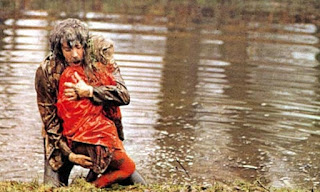The Naked Self Portrait: Women.
(1) Subjectivity.
 |
| Illustration 1: 'Interior Scroll'; two photographs on one print; beet juice, urine and coffee on screenprint on paper; Tate Modern, London, UK; Carolee Schneeman (b. 1939). |
A record of a 1975 performance (New York), in which Carolee Schneeman, controversially, removed a scroll from her vagina and read the text out loud. It describes a conversation with a male film-maker. Schneeman uses her own body as the central component of this work.
The concept of an 'Interior scroll' suggests a specialised awareness to which the individual alone is privy. Our mirror image signifies an object we have an intimate recognition of, but which is the hardest thing to see clearly. If art is primarily a subjective process, its thread of subjectivity is most tightly wound around the artist's sense of self. To represent oneself as a naked object intensifies this conflict. Issues of ego, age, corporeality and sexuality inevitably obtrude. This theme has stimulated artists, female and male, to search for an unidealized vision of their own body.
(2) Objectivity.
 |
| Illustration 2: 'Self Portrait', 1991; Jenny Saville (b. 1970). |
Jenny Saville makes little effort to portray herself as an artist in this work. Maintaining eye contact with the viewer, she is reduced - provocatively - to a bodily, animal function that we all perform daily, but which is generally considered 'unaesthetic' and beyond the bounds of acceptable representation. Art and beauty, particularly female beauty, are often mutually inclusive terms. Realism, however, tends to transgress conventional belief with regard to what is appropriately feminine. The realist claims a right to depict that which may seem ugly, because such a thing exists and is a fact.
"The 'what should be' never did exist, but people keep trying to live up to it. There is no 'what should be', there is only what is" - Lenny Bruce.





























